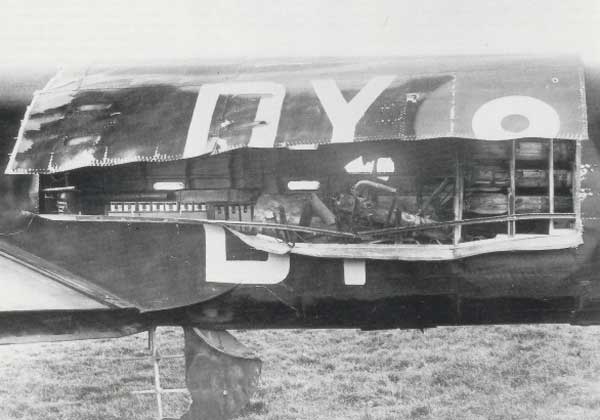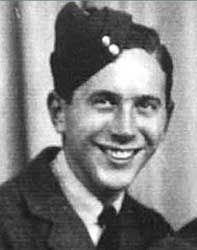Whitley P5005 damaged by enemy fire, returned to Linton on Ouse airfield.
On the night of 12th / 13th November 1940 the crew of this 102 Squadron aircraft was tasked with an operational flight to attack Cologne but on closing in on the target area
the aircraft suffered a problem with the intercom. The delay allowed cloud to cover the intended target so the pilot opted to attack railway marshalling yards nearby. Close to the target the aircraft was hit by two light anti-aircraft rounds which resulted in the cockpit filling with black smoke and the pilot lost control. When he was able to regain control it was found that a flare which was stowed in the aircraft had been hit and had exploded. Further damage was found in the port fuselage which had a hole blown in it and the area was on fire. The fire was put out by the actions of three of the crew and the pilot managed to fly the aircraft back to Linton on Ouse and land the aircraft safely in the early hours of 13th November 1940 after being in the air for 8.5 hours. Two of the crew sustained burn injuries. Whitley P5005 was later repaired and flew again. The photograph below is said to depict the damage sustained to P5005 on this date.
Pilot - P/O Geoffrey Leonard Cheshire RAF (72021).
Second Pilot - P/O Desmond Christian Frederick Coutts RAF (41667).
Observer - Sgt George Roberts RAF (581189). Burn injuries.
Wireless Operator / Air Gunner - Sgt Henry Eugene Davidson RAF (628831). Burn injuries and temporarily blinded.
Air Gunner - P/O Richard Charles Rivaz RAF (78999).
Leonard Cheshire became the War's most famous and most highly regarded bomber pilots. He ended the war as a Group Captain with the VC, DSO and DFC to his name.
His service is well detailed elsewhere on the internet and previously published books. One webpage such as this cannot do the man's life and flying career justice.
Richard Rivaz was born in India in 1908. On 2nd March 1941 he survived the ditching of Whitley T4261 which saw the death of his pilot S/Ldr C E E Florigny.
Unthinkably on the same raid this pilots brother P/O A A Florigny was flying in Whitley T4265 which also was reported missing. Both brothers are commemorated on
the Runnymede Memorial. Rivaz completed his Tour with 102 Squadron and rose through the ranks, he survived the War but was sadly killed on 13th October 1945
while serving with 206 Squadron. He had already published one book entitled "Tail Gunner" in 1943 detailing experiences with 102 and 35 Squadron's and was
researching for a book on the history of RAF Transport Command. His loss and those on Liberator KL595 was very harsh for all concerned. The RAF aircraft and
crew were tasked with bringing troops home from Belgium when the aircraft failed to get into the air on take off from Melsbroek airfield. The aircraft crashed
at the end of the runway and a total of thirty one people on board lost their lives. S/Ldr Rivaz DFC was a passenger on the aircraft, he was thirty seven years
old and is buried in Brussels Town Cemetery.
Henry Davidson also completed his Tour with 102 Squadron. He was serving with 138 Squadron on Special Duties when on 14th April 1943 his aircraft was reported
missing. Halifax BB363 was believed to have crashed into the sea off Bournemouth. He and the other eight on the aircraft are recorded on the Runnymede Memorial.

For their actions on this night P/O Cheshire and Sgt Davidson were awarded the immediate DSO and DFM respectively.
The Citiation reads.."Pilot Officer Cheshire and Sergeant Davidson were the captain and wireless operator respectively,
in an aircraft detailed to attack a target near Cologne one night in November 1940. During a lull, following half-an-hour's
intense and accurate antiaircraft fire, a photographic flare was about to be dropped from a height of 8,000 feet, when
it was detonated by a piece of shrapnel causing a blinding explosion in the fuselage and front turret. The cockpit was
filled with black fumes and fire broke out. Sergeant Davidson was dazed by the explosion, his face and hands were badly
burned and his clothing was set on fire. Snowing great coolness Pilot Officer Cheshire regained control of his aircraft,
which had lost considerable height and was being subjected to intense anti-aircraft fire and although the explosion had
blown out a considerable part of the fuselage and caused other damage, he finally succeeded in regaining height. When the
fire was extinguished, Sergeant Davidson's injuries were so severe that he was unable to see. In spite of this he persuaded
the rear gunner to guide his burned fingers to the wireless controls as he called out the settings, a process which was
continued until it was realised the wireless was useless. Despite his intense suffering, Sergeant Davidson displayed great
courage and fortitude by consistently refusing to be landed at a station nearer than base. Although the aircraft was only
partially answering to controls, Pilot Officer Cheshire succeeded in regaining his aerodrome. He displayed great courage,
determination and leadership throughout."

Desmond Coutts received his commission to the rank of Acting P/O on probation on 4th March 1939, he was graded as P/O on probation on 23rd September 1939 and
later confirmed in the rank of P/O on 28th June 1940. He was soon promoted to F/O on 23rd September 1940. F/O Desmond Coutts was reported missing on 3rd January
1941 flying Whitley T4227 of 102 Squadron and is listed on the walls of the Runnymede Memorial. Whitley T4227 was shot down by Fw Hans Hahn; this Luftwaffe pilot
shot down a number of Allied bombers returning to their North-East bases and a number are listed on this website; one of his victories was Whitley P5073 at
Tholthorpe on 24th October 1940 detailed on this website.


George Roberts later served with 35 Squadron and was made a POW on 8th July 1941 when Halifax L9502 failed to return to Osnabruck.
Whitley P5005 was built to contract 75147/38 by Armstrong Whitworth Ltd, at Baginton and was awaiting collection on 21st May 1940 and after a short period of
MU storage it was taken on charge by 102 Squadron at Driffield in July 1940. The aircraft moved with the unit to Leeming on 25th August 1940, Prestwick on 1st
September 1940 and to Linton on Ouse on 10th October 1940. It sustained Cat.M/FB damage following the incident recorded above and was repaired on site by a team
from A.W. Ltd, and returned to unit before the end of the month. It then sustained damage in a collision at Topcliffe on 28th December 1940 (though 21st and 22nd
December 1940 are also quoted). Following this collission Cat.R/GA damage was recorded and it was transported after Christmas to A.W. Ltd, at Baginton for repair.
Following repair it was issued to 78 Squadron at Middleton St.George but later in the year transferred to 19 OTU at Kinloss. On 15th June 1942 Cat.E2/FA was
recorded when it flew into Burgie Hill, Morayshire during a descent through cloud, sadly two of the five crew were killed.